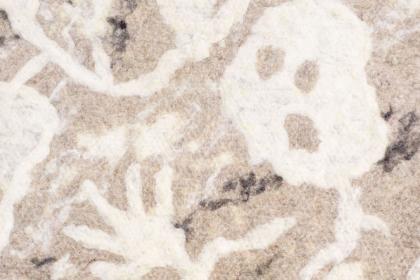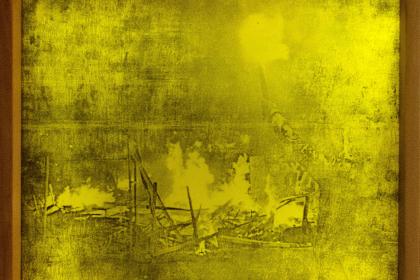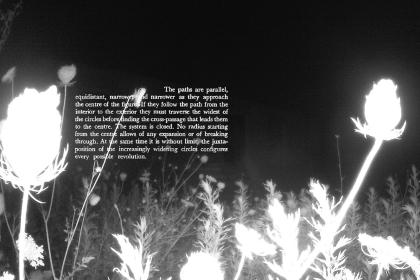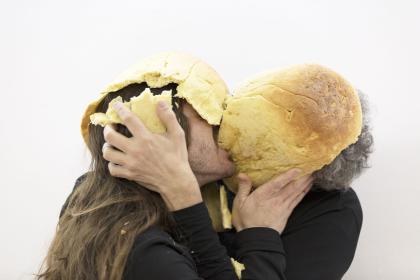Interview with Bénédicte Le Pimpec
Bénédicte Le Pimpec
Célia Picard and Hannes Schreckensberger have been working together since 2013. By carefully observing a given environment, the artists imagine forms and invent new applications for techniques. Whether it’s tools, felt wall hangings or sculptures in the form of dumbbells, their objects are conceived by repurposing techniques, allowing them to create their own production methods.
Bénédicte le Pimpec : Manual skills are very important in your art. The production of your pieces is almost always done by you, and you create methods for learning old techniques that have either been forgotten or transformed by industry, you then make those techniques your own.
Célia Picard: Learning new techniques helps us understand the logic of each thing and the way they work. When you do it yourself, you look at the world differently and gain a better idea of your surroundings.
Hannes Schreckensberger: We’re not trying to master techniques. We’re not trying to be specialists. And it’s not only about making the techniques our own, but also about understanding where raw materials come from, like we did for the project Forces1 . We wanted to make wall hangings, so we went all the way back down the chain of wool production to sheep farmers.
BLP : How did it go?
CP : We were interested in felt wall hangings, partly because of the traditional and universal nature of the technique but also for its domestic aspects. We researched the different ways of producing felt. We watched quite a few YouTube tutorials that identify the different production techniques around the world. Then we decided to produce a series of wall hangings for the Revenir au Monde (Return to the World) residency, organized by the AFIAC association in the agricultural village of Pratviel, in the Tarn, in 2020. We looked for a technique that would be easy to implement, one that would also involve, or at least interest, residents of the village.
HS : Felt is a good choice when it comes to collaborating because it’s easy to use. A few hundred kilometers from here, there’s a farming business that decided to revive wool production. It’s crazy to think about how, often, wool has no value and is mostly thrown out, because processing it is considered too expensive. Sheep are bred mainly for meat in France, while wool is imported from New Zealand.
BLP : What tools were at your disposal during the residency? ?
CP : We had the town hall at our disposal and we turned it into a workshop. We set up there with our wool, water and soap. We had in mind large felt hangings decorated with mystic symbols that Mongolians use as tent walls. They represent natural forces important to their way of life, like wind and rain. So, we tried to find the elements at work where we were located. We chose the ones crucial to soil quality and crop yields: earthworms, fungus and bacteria. These are tiny, even invisible “forces,” in stark contrast to the technological excesses often presented as solutions in farming. We started our designs for the hangings by looking at images taken with electron microscopes.
BLP : These are the motifs on the wall hangings?
HS : Yes, they make up the large patterns with bright colors. But what we were interested in for this project was creating a collective event. At the start of the residency, we asked the locals to help us adapt a production technique used by Mongolian nomadic peoples. It consists in wrapping the wool to be felted around a tree trunk and having it yoked to a camel or horse to be carried across a long prairie. One of the locals was a mechanic and built us a great hitch adapted to fit his mowing tractor. Essential to obtaining felted wool is condensing and compressing the material. We had very little information on the weight, time and distance required in order to succeed. We based things on a few pieces of information we’d found online and estimated the number of roundtrips needed from the water tower to the church located at opposite ends of town.
CP : Then we rolled out, rinsed and dried them in the sun. The reception hall was really a perfect workshop. We presented them on the final evening of the residency along with the hitch and a video loop of the tractor going back and forth. The ten days of the residency were very busy.
BLP : The context of the intervention is often the starting point of your work. Was it your first intervention in a rural environment?
HS : We’ve held several interventions in this type of environment. For instance, a residency at an agricultural school in Montpellier in 2015. Then we were invited to a residency at La Cuisine: Centre d’Art et de Design in Nègrepelisse (Art and design art center in South West of France) in 2016.
BLP : What did you create for the residency at La Cuisine?
CP : Since the residency at the agricultural school, we’ve been interested in tools used in farming. The manual tool became a way of approaching our relationship to agricultural production and thinking about the scale of agriculture. If we can do without tractors, plots can become smaller again. Since the 1960s, there’s been a real push for progress via equipment and technology. Farmers have gone into debt just to be more productive. If we change the tools we use, we can change the scale of plots, and the organization of agriculture as a whole. Both of us are from farming families, we’re familiar with these issues, and the question of reduced soil fertility was also gaining attention at the time.
BLP : So you went out in search of tools used before the industrialization of agriculture? Did you do historical research? Or think about forms?
CP : We looked into agricultural manuals, books held by collectors, and found farmers promoting low technology. We also found catalogues of tools from the 1950s that had an incredible number of forms. And we came to understand how these objects can be so fascinating: their shapes, their mysterious purpose, their direct connection to stories from the past. This led us to think about forms and uses, and play around with myths. We wanted to understand the logic behind the manufacture of classic tools, like a hatchet, for example. There happened to be an edge-tool maker in the town next to Nègrepelisse. The edge-tool maker manufactures sharp objects. There are really very few left and now they generally make knives for collectors. The edge-tool maker was happy to work with us on three possible forms, but wasn’t very open to experimentation.
BLP : So he wasn’t very open to the idea of making unconventional forms? Or to make tools that seemed useless to him? Perhaps your request was unsettling for him as a craftsman, if it seemed to be testing his skills?
HS : Yes, maybe it’s a misunderstanding that prevented us from communicating. But he let us use his workshop and we were able to learn about making different kinds of blades. We also learned what makes one type of steel stronger than another and what makes it cut better, which is essential for a tool.
CP : But we weren’t free to tinker with the very idea of the tool. So, we looked online and started compiling tutorials on manufacturing farm tools. Based on that we invented our own method for manufacturing speculative tools. The idea was to send the scanned sketches directly to a company that performs high-pressure waterjet cutting. It’s a technique for cutting metal and stone that’s fairly affordable. The quality and density of the steel fibers isn’t the same as it would be if you went to an edge-tool maker, but with good sharpening you can get pretty good results. We liked the very natural relationship to the form that this process allows for. We also tested several grips, since, as we learned at the edge-tool maker’s, the grip is half the quality of the hand tool.
BLP :Your residency at La Cuisine ended with the exhibition 2 featuring your tools, videos and two large rugs on which a calendar was printed.
CP : Our interest in farming tools led us to think about measuring time and anticipating the weather. That’s why calendars exist. We designed these two large semi-circular calendar-rugs, thinking of them as a place for assembly and discussion. They’re divided into six months each, and present four plants considered “green” fertilizers: lupin, comfrey, fenugreek and alfalfa. These plants fix nitrogen, fertilize, and aerate the soil. We noted when to plant, cut and enrich the soi with these plants. We also noted astronomical points of reference useful in farming like solstices, equinoxes and moons.
BLP : La Cuisine art center is specialized in projects related to food, asserting that the local population should be involved in the creation process. Was the discussion space you created for the exhibition used to exchange with visitors and locals? What was public reception of the project like?
CP : We spoke with local farmers and craftsmen during the design process, but we didn’t consider that the exhibition might be controversial. We didn’t think we were starting a revolution, but the city council and local farmers didn’t take very kindly to the idea of the exhibition. What’s always amazing at the end of the day is that the first to be impacted by the system are its fiercest defenders. They can’t stand the suggestion that the agricultural system could produce differently, that there are other ways. We weren’t moralizing, we just invented alternative scenarios.
BLP : You think up new forms that allow us to imagine other uses and offer alternative models. In this way, your work isn’t seen as being about form but as a critical perspective on the growth of industrial agriculture. It’s a political position, what sociologist Geneviève Pruvost calls “making the smallest gesture political.” Did other influences inspire you for this exhibition, or more generally?
HS : During the residency, I was reading the novel News from Nowhere or an Epoch of Rest, by William Morris, which is a critique of industrialization in 19th century England. Through the protagonist’s dreams, it imagines a society founded on agriculture and craftsmanship in which money has disappeared. It’s a utopia. What we wanted was to imagine new tools for a new agricultural system.
CP : One of our influences was also Cultura Materiale Extraurbana3 , a study conducted between 1974 and1977 by a group of students studying architecture at the University of Florence, supervised by several members of Superstudio (Adolfo Natalini, Alessandro Poli, and Cristiano Toraldo di Francia) and Lorenzo Netti. The study is a survey of the living conditions and tools of farmers in Tuscany. The study was published in a book presenting an analysis of fully autonomous life in Italy in the 70s.
BLP : References to architecture, specifically modernist, radical architecture are a significant part of your work. Do you both have backgrounds in architecture?
CP : Yes, while studying architecture we did a sort of grand tour of Vienna, Berlin, Rotterdam, Paris and Montpellier. What strikes us in architecture is the way that the discipline can present the ideas and aspirations of an era. Modernist architecture interests us because it’s particularly dense in ideologies of progress. The Western way of imagining progress has only been called into question recently.
BLP : You also created the Revue DAS collection, which looks at relationships between art, architecture and design.
HS : Yes, the third issue is coming out soon. The revue is a space for creation, reflection and a medium to expand on research topics. The first issue is devoted to figures who have worked in different fields. For example, we interviewed Allan Wexler, who studied architecture and then became an artist, or Angela Hareiter, who participated in the radical scene in architecture in the 1960s and 1970s in Austria. She then went into cinema and design. For the second issue, we were interested in vernacular architecture movements from the1970s. The revue is an opportunity for us to ask others to answer questions we’ve asked ourselves, and to understand how other generations posed these questions.
BLP : I have the feeling that you have a very social approach to architecture, and you’re also interested in how architecture can constrain bodies, how norms standardize relationships to space. The exhibition Oracular Workout, which is currently on show at the exhibition space Mécènes du Sud Montpellier-Sète, treats precisely this relationship between athletic bodies, which are necessarily strong, and their space of exercise.
HS : We don’t see architecture as cause but rather as formalization of thought. For this exhibition, we looked at what retreat into domestic space and the valorization of muscular bodies could tell us about our time. There’s an assertion of the individual and the will, fear of illness and protection against a great hostile other. Using these observations, we imagined an interior and objects that could respond to these desires. We were thinking of the model apartments built by Charlotte Perriand or Marcel Breuer, who displays a future, utopian lifestyle, with a health-conscious perspective. We staged this for the exhibition in the form of a closed environment, with the Jungle Gym on one side, made of dumbbells and other objects related to bodybuilding, the Bar à Whey (Whey Bar), a space for wellness with a fountain of youth distributing dietary supplements and the Solarium for communicating with the outside world through social networks.
BLP : The objects are rooted in vernacular forms but they’re designed for the exhibition. They refer to a form but have autonomous sculptural dimensions. Was it to remind us of their use that you added video in which you use the objects to the exhibition?
CP : We like playing with different formal registers. The dumbbells are a mix of athletic-performative aesthetics, tinkering and references to Greco-Roman forms. We developed the objects so that they would be at the threshold of functional and autonomous sculpture. From the beginning, we had this idea of activation, but we didn’t want it to fall into the category of a demonstration, nor of a bodybuilding cliché. We spent a long time trying to find the right way to do it. Whether it should be a performance, a sports routine, digital animation…We came to the conclusion that our own bodies, which are absolutely unspectacular, were representative of the common dimension of individuals looking for their path via physical fitness. I say “path” because there’s a mystical dimension to intensive activities. Even if our work has a critical aspect, we’re not mocking anything. We’d like to understand why one or another phenomenon presents itself as a solution.




